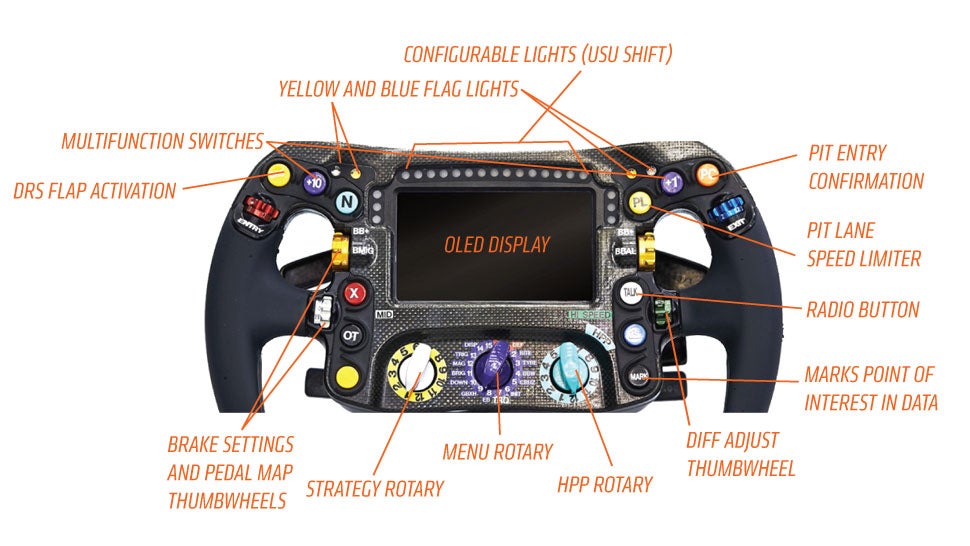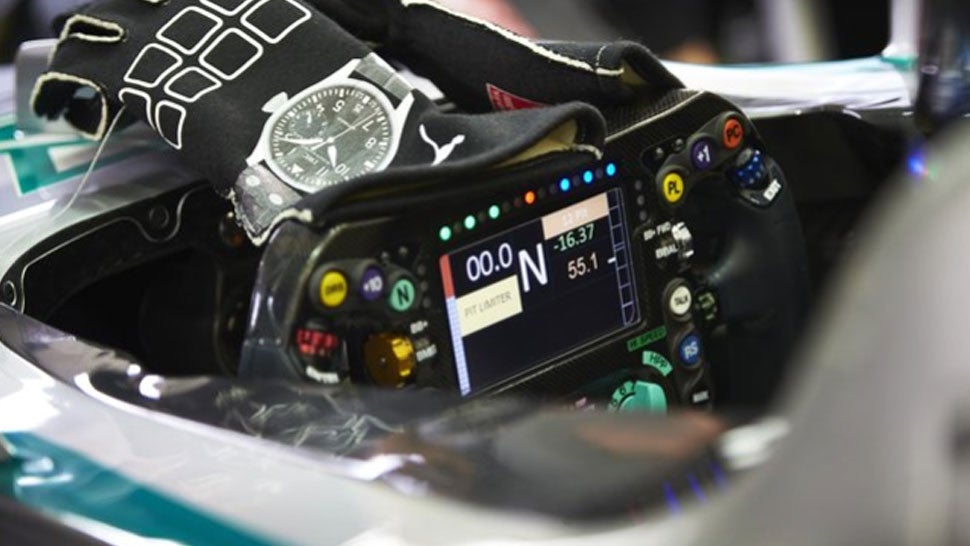Formula One is the most advanced racing series in the world, which means the cars themselves are basically highly complex hybrid hi-tech pods with wheels. How do you pilot a machine like that? With all these buttons.
New regulations for the 2014 season, especially regarding the new KERS setup, meant that the engineers at Benz' F1 team needed to rework their steering wheel. This is the result, and one look should tell you that not every engineering solution is less is more.
The new wheel has some pretty significant improvements over the old one, most notably is that the screen is no longer a simple segmented LED like your old microwave or stair master. The new screen is an actual dot-matrix color OLED screen, and as such is much more capable of displaying information to the driver, with much more flexibility.
 Expand
Expand
Here's what the Mercedes team says everything does, in case you happen to carjack a 2014 Mercedes-Benz F1 car:
 2Expand
2Expand
Now, my real question here is, does anyone think this sort of F1 tech will ever make it to cars you can buy? Say, if we used a split LCD to accommodate airbag exit needs, would you be interested in an all-controls-on-the-wheel setup on, say, a high-end sports car?
Personally, I could see this as being a differentiator on the right super car, but it may be too much of a departure for something more mass-market. Still, could be fun, right?
http://jalopnik.com/heres-what-all-the-buttons-on-the-new-mercedes-f1-whee-1549011631/@ericlimer
New regulations for the 2014 season, especially regarding the new KERS setup, meant that the engineers at Benz' F1 team needed to rework their steering wheel. This is the result, and one look should tell you that not every engineering solution is less is more.
The new wheel has some pretty significant improvements over the old one, most notably is that the screen is no longer a simple segmented LED like your old microwave or stair master. The new screen is an actual dot-matrix color OLED screen, and as such is much more capable of displaying information to the driver, with much more flexibility.

Here's what the Mercedes team says everything does, in case you happen to carjack a 2014 Mercedes-Benz F1 car:
Lights
Left and right lights (FIA standard for red flag, yellow flag, blue flag) Top lights (Configurable, but generally used as gear shift lights)
Rotary Switches
There are a total of nine rotary switches on the wheel. Three are rotary dials, while the remaining six are configured as thumb wheels. The latter allow the driver to make changes to the settings without taking their hand off the wheel.
Rotary Dials
Menu Rotary (Middle) – Allows up to 15 different rotary switches to be able to change multiple configurations in one place, including tyre switches to adjust for the different compounds, for example
HPP Rotary (Right) – Used to control a large number of Power Unit settings, such as energy management during the race or MGU-K settings
Strategy Rotary (Left) – Enables adjustment of strategy settings during a session, including the way energy is recovered / deployed, for example
Thumb Wheels
The right-hand thumb wheels are used for differential adjustment to change the locking torque at different phases of a corner: mid, entry and high-speed The left-hand thumb wheels are used as brake settings for both brake balance and engine braking: adjusting the pedal map and other settings
Buttons
BB- / BB+ – Brake-by-wire management (adjusting the brake balance down / up) OT – The 'overtake' button
N – Neutral
+10 / +1 – Multifunctional switches, located in an optimal position
Radio – Activated the driver to engineer radio
DRS – Operates the DRS flap
Limiter – Engages the pit lane limiter
Marker – Used to identify a point of interest in the data as indicated by the driver
PC/R – Confirms pit entry by sending an automated alert to the garage. This allows the crew to prepare for the arrival of a car, regardless of whether it's been indicated on the radio that the driver is coming in
Key Numbers
It takes around six weeks to build a wheel from start to finish
The servicing time for a wheel between events is around 24 man hours
The team will take three wheels for each driver to every race. These are constantly being modified to suit different settings or preferences throughout the year
Left and right lights (FIA standard for red flag, yellow flag, blue flag) Top lights (Configurable, but generally used as gear shift lights)
Rotary Switches
There are a total of nine rotary switches on the wheel. Three are rotary dials, while the remaining six are configured as thumb wheels. The latter allow the driver to make changes to the settings without taking their hand off the wheel.
Rotary Dials
Menu Rotary (Middle) – Allows up to 15 different rotary switches to be able to change multiple configurations in one place, including tyre switches to adjust for the different compounds, for example
HPP Rotary (Right) – Used to control a large number of Power Unit settings, such as energy management during the race or MGU-K settings
Strategy Rotary (Left) – Enables adjustment of strategy settings during a session, including the way energy is recovered / deployed, for example
Thumb Wheels
The right-hand thumb wheels are used for differential adjustment to change the locking torque at different phases of a corner: mid, entry and high-speed The left-hand thumb wheels are used as brake settings for both brake balance and engine braking: adjusting the pedal map and other settings
Buttons
BB- / BB+ – Brake-by-wire management (adjusting the brake balance down / up) OT – The 'overtake' button
N – Neutral
+10 / +1 – Multifunctional switches, located in an optimal position
Radio – Activated the driver to engineer radio
DRS – Operates the DRS flap
Limiter – Engages the pit lane limiter
Marker – Used to identify a point of interest in the data as indicated by the driver
PC/R – Confirms pit entry by sending an automated alert to the garage. This allows the crew to prepare for the arrival of a car, regardless of whether it's been indicated on the radio that the driver is coming in
Key Numbers
It takes around six weeks to build a wheel from start to finish
The servicing time for a wheel between events is around 24 man hours
The team will take three wheels for each driver to every race. These are constantly being modified to suit different settings or preferences throughout the year

Now, my real question here is, does anyone think this sort of F1 tech will ever make it to cars you can buy? Say, if we used a split LCD to accommodate airbag exit needs, would you be interested in an all-controls-on-the-wheel setup on, say, a high-end sports car?
Personally, I could see this as being a differentiator on the right super car, but it may be too much of a departure for something more mass-market. Still, could be fun, right?
http://jalopnik.com/heres-what-all-the-buttons-on-the-new-mercedes-f1-whee-1549011631/@ericlimer
